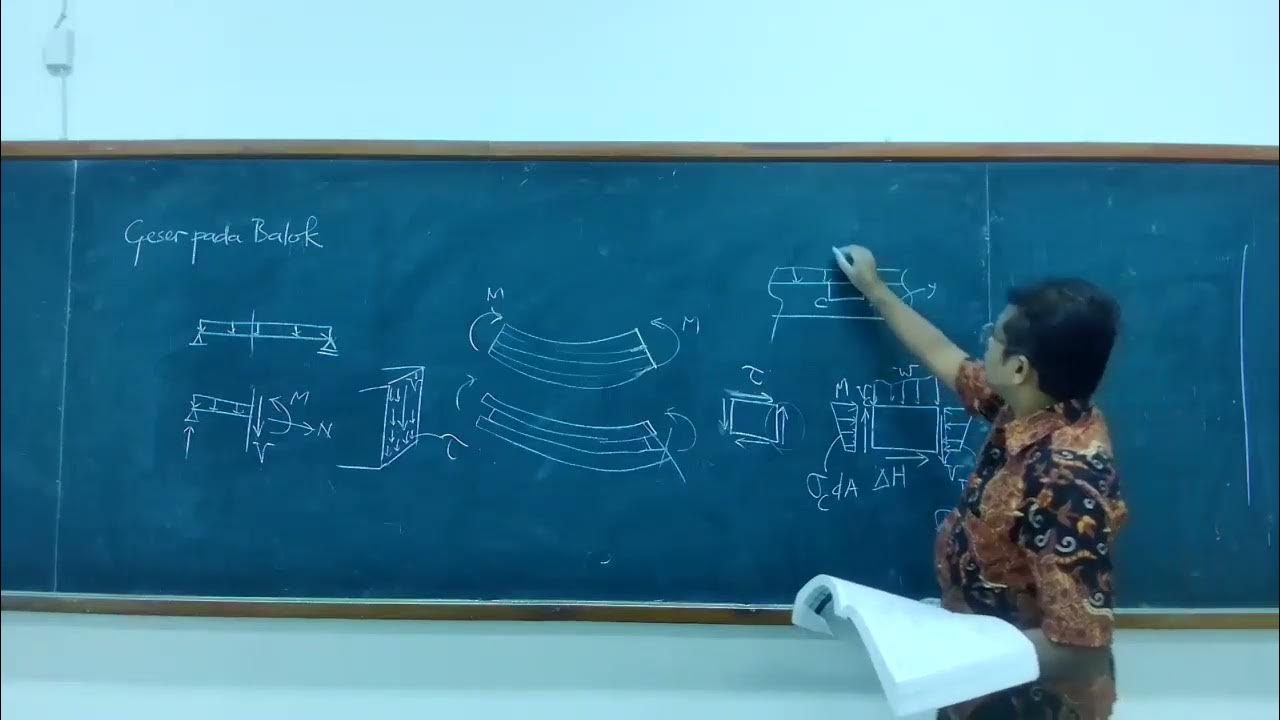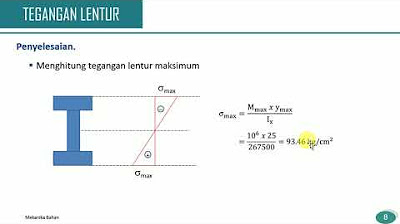Mekanika Statis Tentu: Perbandingan Gaya Geser Dan Momen Pada Balok Dengan Beban Merata Dan Terpusat
Summary
TLDRThis video compares the shear force and bending moment in beams subjected to uniform and concentrated loads. It explains the distribution of reactions, shear forces, and moments in both cases. The uniform load causes a linear reduction in shear force across the beam, while the concentrated load causes a change in shear at a specific point. The moment distribution for the concentrated load is linear, while for the uniform load, it forms a parabolic curve. The maximum moment for both cases is also discussed, providing insights into structural behavior under different loading conditions.
Takeaways
- 😀 The video compares shear force and bending moment diagrams for a beam subjected to uniform and concentrated loads.
- 😀 The session aims to clarify the differences between shear and moment diagrams, particularly for those who are confused by these concepts.
- 😀 For the beam with uniform load, the reaction forces at supports A and B are both equal to QL/2, assuming symmetry.
- 😀 For a beam with a concentrated load at the center, the reaction forces at supports A and B are both equal to P/2.
- 😀 The shear force diagram for a beam with a concentrated load has a constant value until the point of load application, where it changes abruptly.
- 😀 In the beam with a concentrated load, shear force becomes negative after the load point, eventually reaching zero at support B.
- 😀 For a beam with uniform load, the shear force decreases linearly from the left to the right support (A to B).
- 😀 The shear force for a uniformly loaded beam changes gradually, unlike the abrupt change in a beam with a concentrated load.
- 😀 The bending moment diagram for a beam with a concentrated load is linear, while for a uniformly loaded beam, the diagram is parabolic.
- 😀 The maximum bending moment for a beam with a uniform load occurs at the center of the span and is calculated as (QL²)/8, while for a beam with a concentrated load, it is calculated as (PL)/4.
Q & A
What is the main focus of this discussion?
-The main focus of the discussion is comparing the shear force and bending moment diagrams for a beam subjected to uniform and concentrated loads.
How are the reactions at the supports calculated for the beam with a uniform load?
-For a beam with a uniform load (Q) over a span (L), the reactions at both supports A and B are equal and calculated as QL/2 each, assuming symmetry.
What are the reactions at the supports for a beam with a concentrated load?
-For a beam with a concentrated load (P) applied at the center of the span (L/2), the reactions at both supports A and B are equal, calculated as P/2 each.
How does the shear force diagram behave for a beam with a concentrated load?
-For a beam with a concentrated load, the shear force is constant up to the point of load application, then it abruptly changes and becomes negative, returning to zero at the right support.
How does the shear force diagram behave for a beam with a uniform load?
-For a beam with a uniform load, the shear force diagram decreases linearly from the left support to the right support, reflecting the continuous nature of the applied load.
What is the difference in the shear force distribution between the two loading types?
-The shear force for a concentrated load changes abruptly at the point of load application, whereas for a uniform load, the shear force changes gradually and linearly across the span.
What shape does the bending moment diagram take for a beam with a concentrated load?
-For a beam with a concentrated load, the bending moment diagram is linear, as the load is applied at a specific point along the span, causing a linear distribution of moment.
What shape does the bending moment diagram take for a beam with a uniform load?
-For a beam with a uniform load, the bending moment diagram is parabolic, due to the continuous nature of the applied load, leading to a curved distribution of the moment.
How do the maximum bending moments compare between the two cases?
-For the uniform load case, the maximum bending moment occurs at the center and is given by (QL^2)/8. For the concentrated load case, the maximum bending moment occurs at the center and is given by (PL)/4.
What is the key difference in the distribution of shear force between the two types of loading?
-The shear force for the concentrated load is constant until the point of application and then changes abruptly, while for the uniform load, it changes gradually and continuously along the beam.
Outlines

Dieser Bereich ist nur für Premium-Benutzer verfügbar. Bitte führen Sie ein Upgrade durch, um auf diesen Abschnitt zuzugreifen.
Upgrade durchführenMindmap

Dieser Bereich ist nur für Premium-Benutzer verfügbar. Bitte führen Sie ein Upgrade durch, um auf diesen Abschnitt zuzugreifen.
Upgrade durchführenKeywords

Dieser Bereich ist nur für Premium-Benutzer verfügbar. Bitte führen Sie ein Upgrade durch, um auf diesen Abschnitt zuzugreifen.
Upgrade durchführenHighlights

Dieser Bereich ist nur für Premium-Benutzer verfügbar. Bitte führen Sie ein Upgrade durch, um auf diesen Abschnitt zuzugreifen.
Upgrade durchführenTranscripts

Dieser Bereich ist nur für Premium-Benutzer verfügbar. Bitte führen Sie ein Upgrade durch, um auf diesen Abschnitt zuzugreifen.
Upgrade durchführen5.0 / 5 (0 votes)






